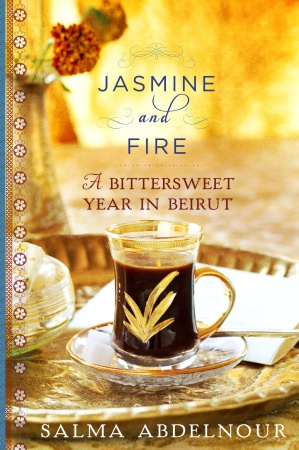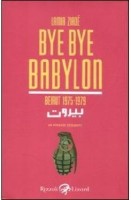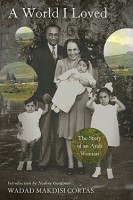Jasmine and Fire, by Salma Abdelnour
 Without the subtitle (“a bittersweet year in Beirut”), it sounds a bit like a torrid romance, and I suppose I was expecting some bodice-ripping or other high drama, so it took me a little while to get into its groove.
Without the subtitle (“a bittersweet year in Beirut”), it sounds a bit like a torrid romance, and I suppose I was expecting some bodice-ripping or other high drama, so it took me a little while to get into its groove.
But in the end I was glad for it not to be a high-drama book (as so much else around here is intense). Instead it’s a low-key sort of travelogue and a meditation on what it means to be at home somewhere. And the reason I jumped at reading it (the publisher offered me a copy–it’s officially released tomorrow) is because I know Abdelnour as a food writer, so I figured that angle would be good too. And in that respect especially, it has been a great introduction to the city–Abdelnour uses food to explore Beirut, by heading off on a walkabout to the famous shwarma place, for instance, or trying out the odd processed cheese (Picon) she used to like as a kid.
Abdelnour left Lebanon with her family as a child, early in the civil war, and in the book she returns to Beirut and the apartment her family has kept, to see if she feels like she fits in better here than she did back in the U.S. Each chapter covers a month, and it glides along easily, in the present tense.
What was odd about reading it is that it was eerily in sync with what I was doing at the time. Every time I cracked open the book, it was like reading my own notes: Wait, I just walked that exact same route through the city! I just went to Tell Arqa and Akkar! I just ate that eggplant fatteh at Al Balad!
So I could write a blog post about this stuff…but you could just read this lovely book. To make it a bit easier, I’m running a giveaway of Jasmine and Fire: enter on my Facebook page.
Jasmine and Fire is very much about present-day Beirut. But I’ve also read a couple of books about the past–where the picture of the city grows a lot murkier.
Bye Bye Babylon, by Lamia Ziade
 This is a short graphic novel about the good old pre-war days. Or it is at first: colorful, somewhat childish watercolor illustrations show tan ladies by the sea. But that Beirut is gone within a few pages, and the rest of the story is the author’s childhood recollections of the war–the images and the language are simple, but the story is concise and all too brutally clear.
This is a short graphic novel about the good old pre-war days. Or it is at first: colorful, somewhat childish watercolor illustrations show tan ladies by the sea. But that Beirut is gone within a few pages, and the rest of the story is the author’s childhood recollections of the war–the images and the language are simple, but the story is concise and all too brutally clear.
What I found gripping was almost incidental. At one point, Ziade details all the various militias and their insignias, with slightly comical drawings of typical militia members (one machine-gun toting woman wears an oh-so-seventies rainbow T-shirt). I knew, abstractly, that many of the militias and political wings established during the war still exist in Lebanon—but seeing them laid out here, and illustrated, made me realize it concretely: Phalangists, Lebanese Forces, Amal–I’ve seen their flags in various parts of the city and around the country, marking turf. The fact that all these groups still exist—after doing such barbaric things during the war (which are detailed in this book)—is more unsettling than I’d had time to consider, especially when juxtaposed with the otherwise glossy image Beirut has now.
A World I Loved, by Wadad Makdisi Cortas
 I’m only halfway through this, but I’m liking it a lot—Cortas was a passionate educator who ran a prestigious girls school in Beirut, and this is her memoir. Like Bye Bye Babylon, it’s also deeply nostalgic, but it doesn’t candy-coat anything. It also starts in an earlier era, during World War I, when the Ottoman empire was dismantled. Reading these two books in succession is not exactly comforting—I’m getting a strong sense of how deeply wrong things went in the colonial era, and how that still echoes everywhere. It’s the kind of thing you learn in grad school—colonialism is bad, sure—but it’s not until you’re actually in a place, and see that people have been working over the same problems for decades, and still are, that it really sinks in.
I’m only halfway through this, but I’m liking it a lot—Cortas was a passionate educator who ran a prestigious girls school in Beirut, and this is her memoir. Like Bye Bye Babylon, it’s also deeply nostalgic, but it doesn’t candy-coat anything. It also starts in an earlier era, during World War I, when the Ottoman empire was dismantled. Reading these two books in succession is not exactly comforting—I’m getting a strong sense of how deeply wrong things went in the colonial era, and how that still echoes everywhere. It’s the kind of thing you learn in grad school—colonialism is bad, sure—but it’s not until you’re actually in a place, and see that people have been working over the same problems for decades, and still are, that it really sinks in.
What I’d really be interested to read is a memoir by an active militia member during the war. So far everything I’ve seen is by innocent bystanders. But I know the war’s real participants are still around. When I was standing in front of the shell of the Holiday Inn, listening to a tour guide explain the building’s strategic significance, a man drove by and shouted out his car window, fist raised in triumph, “I fought in that building!” Where’s his story?
**Remember: Go enter the Jasmine and Fire giveaway on my Facebook page!